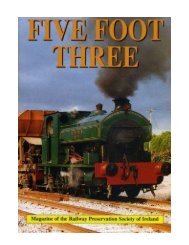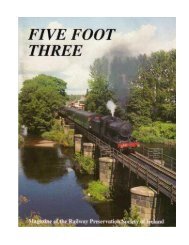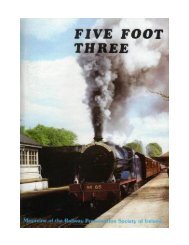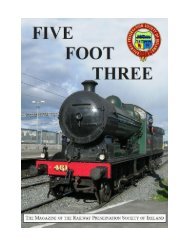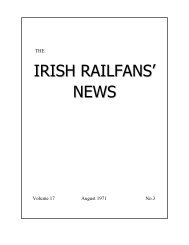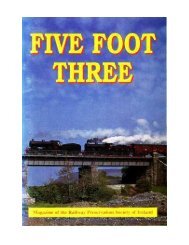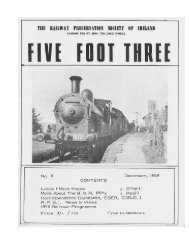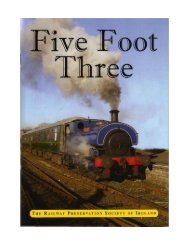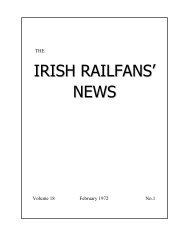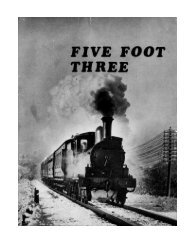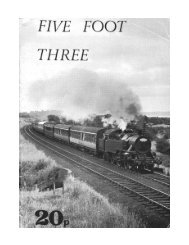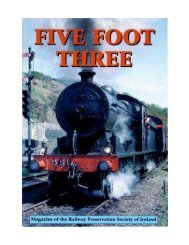Five Foot Three Number 14 - Railway Preservation Society of Ireland
Five Foot Three Number 14 - Railway Preservation Society of Ireland
Five Foot Three Number 14 - Railway Preservation Society of Ireland
Create successful ePaper yourself
Turn your PDF publications into a flip-book with our unique Google optimized e-Paper software.
Towards the end <strong>of</strong> July, when Mr Huston was waiting for the final component drawings and the<br />
makers were reassuring the insurers that the valves were properly secured to the boiler, it was decided<br />
to run the new engine the other way round from the other “ones” (sic) and the narrow gauge coupling<br />
had to be repositioned.<br />
Eventually, then, the work got under way in late August and the last details about the paintwork and<br />
position <strong>of</strong> lamp brackets were settled. The boiler was hydraulically tested on 27 th September and held<br />
240 lbs for thirty minutes and a steam pressure <strong>of</strong> 160 was decided upon. The engine was successfully<br />
steamed the following day when she blew <strong>of</strong>f at 170 lbs.<br />
The engine was steamed again on 12 th October for the insurers - the Commissioners had been invited to<br />
send a representative but declined and asked the insurers to act for them.<br />
With the work completed to everyone’s satisfaction the engine left Bristol on 19 th October and was<br />
shipped from Heysham on the 24 th accompanied by an Avonside mechanic. The engine was sent<br />
completely erected except for the cab which was removed for lifting purposes. The loco arrived on<br />
Sunday 28 th October 1928 and one could do no better than quote the report sent to the General Manager<br />
<strong>of</strong> the Commissioners by Mr Huston.<br />
“The new locomotive ordered from Avonside arrived here on Sunday last and was safely landed on the<br />
rails using the 50 ton steam derrick. Some fitting had then to be done and the trials were proceeded<br />
with on Tuesday 30 th and have continued to date. On Tuesday a rake <strong>of</strong> 36 loaded wagons weighing<br />
468 tons and about 240 yards long was hauled along the quays to the Great Northern <strong>Railway</strong> on wet<br />
and greasy rails and round curves and reverse curves. The same evening 19 <strong>of</strong> these wagons were<br />
hauled up the bridge slope - a gradient <strong>of</strong> 1 in 64. I consider these tests very severe and the locomotive<br />
carried them out satisfactorily. I also tried the locomotive around all the worst curves which were<br />
negotiated without difficulty. Since then the locomotive has being doing the ordinary shunting<br />
efficiently worked by our own men. Some difficulty was experienced at first by the fireman in the<br />
management <strong>of</strong> his fire as the firebox is lower than that <strong>of</strong> the old engine, but he has got quite used to it<br />
now. I have had to get some slight alterations made to certain fittings and I may have to adjust the<br />
narrow gauge buffers when the Engine has settled down on its bearings, but this is not a serious<br />
matter.”<br />
By mid-November all was not well with the lubricator and Mr Huston wrote to Avonside in hopes that<br />
they would recommend an oil considering that the engine normally travelled at “only about two miles<br />
per hour”. He also reported that the regulator was “so stiff as to be almost unworkable” and that the<br />
engine was drawing air around pipes at the bottom <strong>of</strong> the smokebox. Mr Huston asked for advice, too,<br />
regarding the quality <strong>of</strong> coal to be used, quoting that the Commissioners used coal from Auchincruive<br />
in Ayrshire.<br />
Perhaps not surprisingly Avonside knew little <strong>of</strong> this coal but suggested that excessive spark throwing<br />
could be cured by boring out the blast pipe orifice to 3 5 /8 inches. After detailing the operation <strong>of</strong> the<br />
mechanical lubricator, Avonside suggested repacking the regulator stuffing box and recommended<br />
Wakefield oil. It appears that the nameplates were not supplied until late in November when Avonside<br />
suggested where they should be mounted.<br />
It was about the same time that the bill for the engine came to hand. The final total was £1,916.18.0 and<br />
Mr Huston queried the £16.18.0, deferring payment <strong>of</strong> it until matters had been resolved. Several<br />
alterations and repairs, apparently, had had to be made (including a defective narrow gauge coupling<br />
which broke during shunting). By January 1929 a list <strong>of</strong> the alterations made to No.3 was furnished to<br />
Avonside, the cost <strong>of</strong> these was to <strong>of</strong>fset the disputed £16.18.0. Among other things the rail guards had<br />
to be altered, a fusible plug had to be renewed (it dropped at 100 lbs) and the time <strong>of</strong> the fitter dealing<br />
with the stiff regulator allowed for (nineteen hours!).



